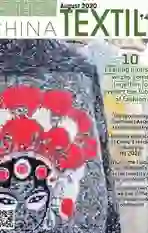What’s the status quo of Hubei’s textile industry in post-pandemic?
2020-11-09EditedbyZhaoXinhua
Edited by Zhao Xinhua

At present, textile companies are still facing greater pressure on production and sales, and some companies are in the dilemma of reducing and stopping production. The overall situation is not optimistic. Hubei is a major province in Chinas cotton spinning industry. According to the data from the Department of Economics and Trade of the National Development and Reform Commissions declaration of tax quota textile enterprises, the textile scale of Hubei Province in 2018 was close to 6 million spindles, and the annual cotton consumption exceeded 610,000 tons. The output is close to 520,000 tons, ranking fifth in the country. How big is the impact of the pandemic?
The pressure on textile enterprises in Hubei is greater than in other regions, mainly because the pandemic has lasted for a long time and has a deep impact.
Since the outbreak of the pandemic, Chinas cotton spinning industry has experienced a cliff-like decline, es- pecially in foreign trade. The textile and apparel export data in the first half of the year is the best proof. From January to June 2020, the cumulative export value of Chinas textile and apparel was USD 125.188 billion, of which the cumulative export value of apparel was USD 51.0844 billion, a year-onyear decrease of 19.39%.
According to Hubei textile companies, during the pandemic, the speed of resumption of work and production in Hubei was slower than that of other parts of the country. It was not until April that the production and operation of enterprises completely returned to normal. However, the pandemic situation abroad spread rapidly, and the situation of foreign trade orders across the country is getting more and more severe. Not only a large number of foreign trade orders defaulted, and there is a serious shortage of new orders, and corporate sales are facing great pressure. The interviewed companies also stated that Hubei cotton yarn was rejected in other parts of the country when the pandemic was the worst.
From the perspective of corporate raw material and product inventory, the cotton inventory of the interviewed companies maintained an average of about one and a half months, maintaining a normal level, and the cotton yarn inventory showed signs of accumulation, which was at a higher level than in previous years, mainly due to fewer downstream orders and high sales pressure.
As the domestic and foreign markets are changing, Hubei enterprises actively adjust their production lines and strive to open up the domestic consumer market.
The person in charge of a state-owned textile enterprise in Wuhan, Hubei, told reporters that in the past few years, the company has made efforts in the high-end cotton yarn market and purchased world-class cotton yarn production equipment. It mainly produces combed 80S and 100S yarns. The main reason is that state-owned enterprises do not have an advantage in the low-end yarn market, and the production of high-value-added products is the direction of development. However, the sudden outbreak of the pandemic disrupted the pace of development of the company. Due to the restrictions of foreign trade and export, the high-end yarn market has fallen sharply, so it can only develop the domestic medium and low-end market. Each piece of production equipment worth tens of millions producese mid-end yarns such as combed 40, which is really overkill.
Although this phenomenon is rare in Hubei Province, the domestic middle and low-end market does require companies to seek change and survive. According to the company, foreign trade orders are mostly high-end yarns, and the domestic market is mostly middle and low-end yarns. Affected by the foreign pandemic, corporate orders are now mainly for the domestic market. With the restoration of normal domestic production order, the traditional enterprises that have always focused on the domestic market have maintained stable orders and full production due to stable customer relationships. However, some enterprises that do foreign trade or produce high-end products are under great pressure. As an outsider in the domestic market, it is not easy to get into this market.
The cotton price has a small fluctuation range, which provides companies with a relatively stable living space.
Looking back at the trend of the first three months of Zheng Cottons 2009 contract this year, the vibration range was basically maintained at 11,000 - 12,500 yuan/ton, especially after the domestic pandemic was relatively stable, the volatility narrowed, which provides a good opportunity for the development of the cotton spinning industry. The upstream raw material market is stable, which guarantees downstream processing of finished products.
In this survey, the interviewed trading companies said that chemical fiber has been subject to large fluctuations in crude oil and the price has changed greatly, while pure cotton has been relatively stable, and the price of cotton yarn has declined slightly due to market supply and demand. In addition, the difference between domestic and foreign cotton prices has narrowed, and textile companies have given priority to domestic cotton when purchasing raw materials, which has played a role in supporting domestic cotton prices to a certain extent. At present, the price of lint in China is about 12,000 yuan/ton, while the price of Indian cotton shipped to Hubei is 11,800 yuan/ton. This price difference causes the loss of the price advantage of imported cotton.
In response to the trend of cotton prices in the later period, under the interaction of the macro environment, the pandemic situation, and Sino-US economic and trade relations, cotton prices will still be struggling for a period of time. To the reporters surprise, in this interview and investigation, despite the severe situation of the cotton spinning industry, industry professionals are relatively optimistic about next years price trend and remain confident in the future development of the cotton spinning industry.
